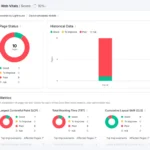
Introduction
Google’s Core Web Vitals have been a cornerstone of website optimization since their introduction in 2021. These metrics were designed to measure how fast, stable, and responsive a webpage feels to users. In 2025, Core Web Vitals are evolving again, and understanding these changes is essential for maintaining strong rankings and superior user experience.
This guide breaks down what’s changing in the Core Web Vitals update 2025, why it matters, and how you can stay ahead of the curve.
What Are Core Web Vitals?
Core Web Vitals are a set of user-experience metrics that Google uses to evaluate how users perceive the performance of your website. They focus on speed, responsiveness, and visual stability — key elements that directly influence engagement and bounce rates.
The current Core Web Vitals include:
- LCP (Largest Contentful Paint): Measures loading performance. Ideal score: under 2.5 seconds.
- CLS (Cumulative Layout Shift): Measures visual stability. Ideal score: less than 0.1.
- INP (Interaction to Next Paint): Replaces FID (First Input Delay) as of 2024 and measures interactivity. Ideal score: under 200 milliseconds.
These metrics help Google determine whether a site provides a good user experience, which impacts its ranking signals in search results.
What’s Changing in 2025
The Core Web Vitals update 2025 brings refinement rather than a complete overhaul, but even subtle shifts can significantly affect your site’s SEO performance.
Here are the major changes to watch:
1. More Weight on INP (Interaction to Next Paint)
Since INP replaced FID, Google is putting greater emphasis on responsiveness. Websites that delay user interactions — such as slow menus or laggy buttons — will see performance scores drop. Fast interactivity is now a ranking differentiator.
2. Mobile Experience Takes Priority
With over 70% of global traffic now mobile, Google is doubling down on mobile-first indexing and mobile Core Web Vitals. Expect stricter performance thresholds for mobile versions of websites. A site that performs well on desktop but poorly on mobile may lose rankings.
3. Smarter Measurement Through Chrome UX Report
The 2025 update uses more user-centric data from the Chrome User Experience (CrUX) dataset. This means Google’s evaluation reflects real-world performance, not just lab tests. Optimization should focus on real visitor behavior, not theoretical benchmarks.
4. Page Experience Integration
Core Web Vitals will merge more deeply into the broader Page Experience Update. Security (HTTPS), intrusive interstitials, and accessibility will play a more connected role in determining search visibility.
5. New “Viewport Responsiveness” Metric (Experimental)
Google is testing a new metric called Viewport Responsiveness to measure how quickly visible elements adjust when users interact. If implemented, it could become a part of Core Web Vitals in late 2025.
Why Core Web Vitals Still Matte
In 2025, Core Web Vitals continue to influence both rankings and conversions. A site that loads quickly and feels smooth retains visitors longer and reduces bounce rates — signals Google uses to rank high-quality pages.
According to Google’s research, improving page load speed by just one second can increase conversions by up to 20%. This makes optimization not just an SEO priority but a business imperative.
How to Stay Ahead: Practical Optimization Tips
1. Optimize Loading (LCP)
- Use modern image formats like WebP or AVIF.
- Implement lazy loading for images and videos.
- Reduce render-blocking scripts by deferring JavaScript.
- Use a reliable CDN to serve content faster globally.
2. Improve Interactivity (INP)
- Minimize main-thread blocking JavaScript.
- Use code splitting to load only what’s needed.
- Ensure third-party scripts (like chat widgets or analytics) don’t slow down interaction.
- Prioritize critical user actions (e.g., button clicks, form submissions).
3. Ensure Visual Stability (CLS)
- Set fixed dimensions for images and embeds.
- Avoid dynamic content that shifts the layout after load.
- Preload custom fonts to prevent flash of unstyled text (FOUT).
4. Audit Regularly with Tools
Use reliable measurement platforms to track your progress:
- PageSpeed Insights (Google) – Quick Core Web Vitals test and suggestions.
- Lighthouse – Detailed audit inside Chrome DevTools.
- WebPageTest.org – Visual filmstrip of how pages render.
- Search Console – Core Web Vitals report for your domain.
5. Focus on Mobile-First Performance
- Use responsive design.
- Test with Google’s Mobile-Friendly Test.
- Avoid large pop-ups or intrusive interstitials.
Common Mistakes to Avoid
- Ignoring real-user data: Don’t rely solely on lab tools. Optimize based on field data.
- Over-optimizing desktop only: Mobile users matter more than ever.
- Skipping content optimization: Fast pages still need relevant, valuable content for rankings.
- Neglecting server performance: A slow hosting provider can undermine every other effort.
As Google’s algorithm becomes more user-centric, Core Web Vitals will continue evolving. AI and predictive models may soon help webmasters forecast performance drops before they occur. Expect integration between Core Web Vitals and AI-driven site monitoring tools by late 2025.
FAQs
1. What are the new changes in Core Web Vitals 2025?
The 2025 update gives more importance to INP (Interaction to Next Paint), integrates real-user data, and tightens mobile performance benchmarks.
2. How can I check my Core Web Vitals?
You can use Google Search Console, PageSpeed Insights, or other reliable SEO tools like SEMrush or Ahrefs to measure your Core Web Vitals scores and identify improvement areas.
3. Do Core Web Vitals affect SEO rankings?
Yes. Google includes Core Web Vitals as a ranking signal under its Page Experience algorithm. Sites with better performance metrics often rank higher.
4. What’s the difference between INP and FID?
FID (First Input Delay) only measured the delay of the first user interaction, while INP evaluates all interactions, giving a more complete view of responsiveness.
5. How do SEO tools help with Core Web Vitals?
SEO tools provide automated audits, detect slow-loading elements, and track changes over time, making it easier to maintain good performance and user experience.
6. What’s the ideal Core Web Vitals score?
- LCP: < 2.5 seconds
- INP: < 200 milliseconds
- CLS: < 0.1
Visit our services – SEO services in Kanpur | SEO services in Surat | SEO company in Jaipur | SEO comapany in Lucknow| SEO company in Ameerpet





